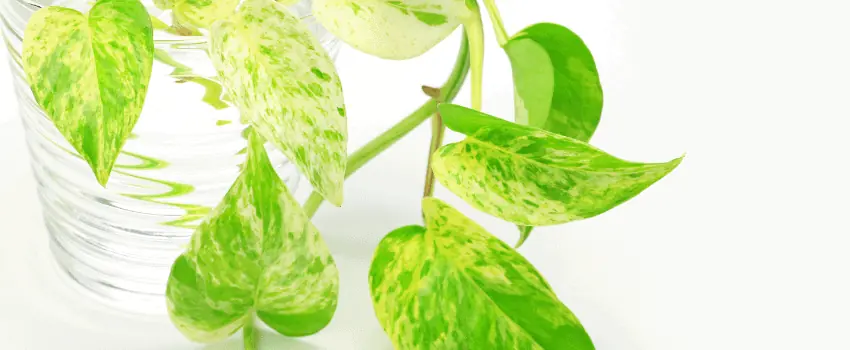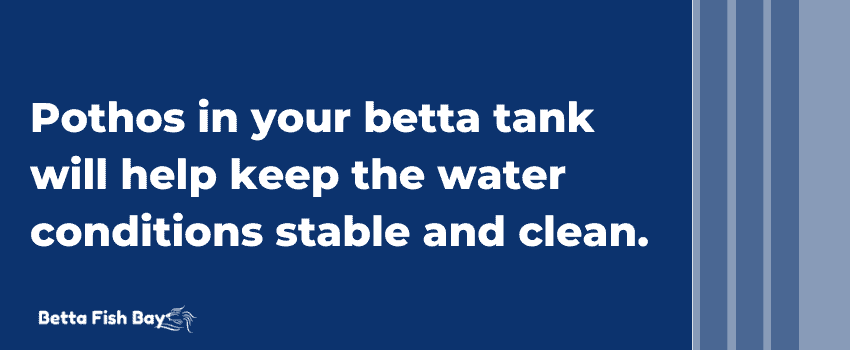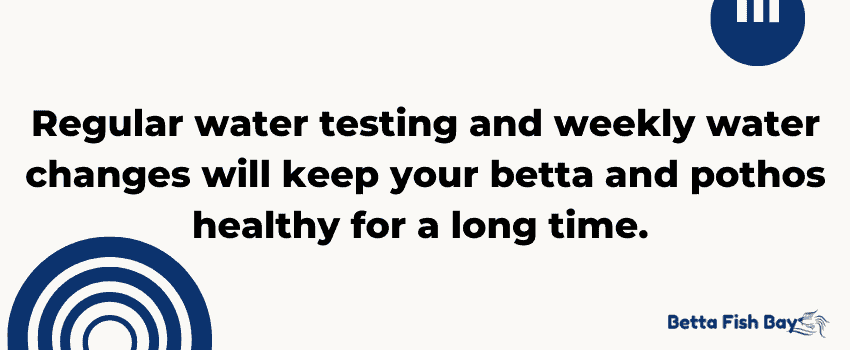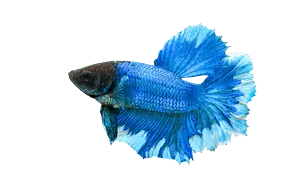The houseplant Pothos (Epipremnum aureum) is very popular, and for a good reason. A tropical plant is resistant to humidity, can root in plain water, and trails prettily.
But is it good for your aquarium? Many aquarists are turning to Pothos plants for a safe and beautiful aquarium plant.
The question is, is pothos in betta tanks safe?
The stems and leaves of the Pothos plant contain insoluble calcium oxalates. Ingesting these chemicals causes stomach irritation and swelling, and central nervous system problems. The roots of the Pothos plant are safe, however.
Bettas are also carnivores and do not eat plants unless they are starving. Your betta should be safe with a Pothos plant in your fish tank.

Table of Contents
What is Pothos?
The Pothos plant is a popular and easy-to-grow houseplant. It is a member of the Araceae family and is native to the Solomon Islands in the South Pacific.
It also goes by common names such as Devil’s Ivy, Ivy Arum, and Hunter’s Robe.
Pothos plants have long, trailing stems that can grow several feet long. The leaves are heart-shaped and typically green or variegated with white or yellow.
Be aware that the plant can grow aerial roots and attach itself to supports, such as walls or trellises.
Pothos plants are known for their air-purifying qualities. They are commonly used in offices and homes to improve indoor air quality.
They are also low-maintenance. Pothos can survive in a variety of light and temperature conditions.
Why Use Pothos Plants?

Fishkeepers sometimes use pothos plants in aquariums as a natural filter. This helps maintain good water quality.
They place the plant in the aquarium water with its roots submerged. The leaves and stems grow out of the water.
As the plant grows, it absorbs nutrients from the water, such as nitrates and phosphates. This competition for nutrients helps prevent algae growth.
Algae use the same nutrients as aquatic plants. Pothos improves the overall health of the aquarium by competing with algae and filtering the water.
Some aquarists plant the Pothos directly in the filter media compartment. This will improve their water chemistry through biological filtration.
Besides its filtering properties, Pothos adds a decorative touch to the aquarium. Its trailing vines and lush green leaves create a natural-looking environment.
The tangled roots of the Pothos plant provide enrichment for your Betta, who will swim in them and hide or rest. If your betta has tank mates, this spatial separation is important to keep your fish happy.
The Pothos can survive and even thrive in a range of conditions. It is important to watch for a nutrient deficiency and fertilize if necessary.
Are Pothos Plants Safe for Betta Fish?
The stems and leaves of the Pothos contain dangerous insoluble calcium oxalates. The roots of the plant are safe.
Bettas do not eat plants anyway. They are carnivorous fish and eat meat proteins.
If your betta is starving enough to nibble on a Pothos plant, you are not feeding it enough.
What do Betta Fish Eat?
Since we know Bettas won’t eat a Pothos plant, what do they eat?
Bettas enjoy a varied diet with brine shrimp, bloodworms, and other frozen live food. Bettas also eat betta pellets and flake food, which are easy to store.
Your betta will find live food stimulating and tasty. They like mosquito larvae and daphnia.
Don’t just dump the live food in the tank with the water it came in; it could be contaminated. Similarly, do not feed your pet food acquired outside in your backyard.
This will help reduce your risk of contagion. Some fish keepers even have their own brine shrimp nurseries to feed to their bettas.
A well-nourished fish will be more resistant to bacterial diseases. Do not overfeed your betta, however.
Overfeeding leads to problems like bloating and swim bladder disorder. They only need an amount of food equal to about the size of their eye.
Uneaten food breaks down in the tank and raises ammonia and nitrite levels. This necessitates more water changes.
Water Quality for your Betta

As with all fish, maintaining good water quality is important for the health of your fish.
The ideal water parameters for betta fish are a temperature range from 78 to 80° degrees Fahrenheit (25.5-27° C).
Use a good, submersible aquarium water heater to maintain this temperature.
Keep pH levels between 6.5 to 7.5, checking with test strips or similar on a regular basis.
Bettas like slightly softer water, so monitor hardness as well.
Poor quality of water leads to stress in your fish, which leads to illness or infection. A stressed fish is vulnerable to bacterial, parasitic, and fungal infections.
Phytoremediation is the use of green plants to reduce contaminants in the air, soil, or water. It plays an important part in why Pothos plants are so useful as houseplants and in the aquarium.
The Pothos plant increases the production of helpful bacteria. It also removes carbon dioxide from the water, and adds oxygen.
Pothos plants help keep nitrate levels down, which is healthier for your betta. High nitrate levels in the tank water will cause stress for your betta.
The long-term effects of nitrate on bettas have not been studied. Lots of nitrates may shorten your fish’s life span.
Some nitrate showing up is a sign the nitrogen cycle is working. Beneficial bacteria in the tank convert ammonia from waste into nitrite.
More bacteria then convert nitrite to nitrate. This is the nitrogen cycle.
Aquatic plants are a fishkeeper’s friend. They remove nitrates from the water.
A safe nitrate level in a betta tank is between 20-40 ppm. Plants absorb this nitrate as a nutrient and thus help maintain your tank’s water quality.
Test water parameters and do partial water changes weekly. This will also help keep nitrate levels in check.
Advantages of Growing Pothos in Your Aquarium
Pothos plants are safe to grow in your betta’s tank. They are low-maintenance and look nice.
It is possible to grow a plant from a single Pothos leaf. The plants grow rapidly when nourished by lots of fish waste.
Do not put the Pothos plant in direct sunlight; it will damage the leaves.
You don’t want your aquarium in direct sunlight, anyway.
Indirect sunlight works best for growing Pothos.
Pothos plants work really well to beautify your aquarium without a lot of work. They also provide enrichment for your betta.
Water Purification
All aquarium plants help keep your water cleaner. Pothos plants are especially good at absorbing nitrates, nitrites, and carbon dioxide.
This natural filtration process makes Pothos a great addition to your betta tank. This is particularly important for smaller tanks.
Because Pothos is such a resource-hungry plant, it competes with algae. This keeps the algae population in your tank under control.
Taking Care of Your Betta’s Home

Water quality matters to aquarium health. Regularly test for nitrate, nitrite, pH, ammonia, hardness, and temperature levels.
Perform partial water changes and vacuum substrate weekly. If water parameters are good, your betta will be happier, healthier, and have better color.
Your betta needs to have a clean, safe environment to thrive. Ensure artificial plants and decorations do not have sharp edges.
Look for rust or flaking paint on your decor. They are unsafe for your fish.
Caves, floating logs, or large rocks make nice decorations for a betta tank. They provide hiding and resting places for tired fish.
Clean algae off of artificial plants and decorations as necessary. Or, get some large aquarium snails.
Enrichment for Your Betta
Enrichment, or simulating the natural environment, is important for your fish. Bettas are clever fish and do get bored.
Pothos plants have an enticingly tangly, stringy root system. This will keep your fish entertained and sheltered.
They also add gentle movement and color to the tank.
Your betta will love hiding in the Pothos roots if they have tank mates. Providing these places is important to reduce aggression and stress in the tank.
Growing and Caring for Pothos Plants in Betta Fish Tanks
Pothos grows from cuttings. Cut the stem diagonally on the left side using scissors or a knife.
Put the cuttings in a cup or container of plain, unchlorinated water. The roots will soon sprout, and the cuttings will be transferable to your tank.
Pothos plants are very easy to care for in your betta fish tank. As it roots in water and grows upwards, you will need to ensure it has room to grow outside the tank.
Use the aquarium lid to hold the plant securely so it won’t fall in. The leaves must be above the water’s surface, or the plant will suffocate.
It is a pretty tough plant, so don’t be afraid to trim it as necessary.
These beautiful plants purify the water column nicely. Their roots provide shelter for your fish.
Ideal conditions for the pothos plant are a tank with natural or artificial light. And an adequate bio-load to support its nutrient needs.
Pothos Upgrades Your Betta Tank
Pothos plants make a great and attractive addition to any fish tank. Your betta will appreciate the clean water and enrichment they provide.
Growing this hard-to-kill and fast-growing plant is easy and inexpensive. It is worth the small effort involved.
For other plants, check our list of the best plants for betta tanks in the article here.


